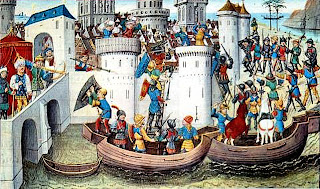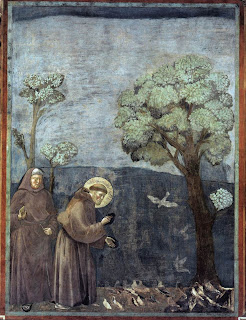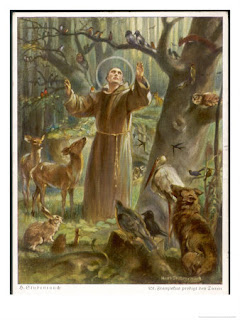Week 10: Courtly Culture and Literature in the Middle Ages/Later Crusading
Tutorial Discussion Post
By: Maddi, Avalon, Steve, Phil, Paul and Jamie
Phil's thoughts,
What does he
(Runciman) mean when he refers to a ‘melancholy pile of
misunderstandings’
throughout the First Crusade?
When did it
all go so tragically wrong for the fabled alliance between
Eastern and
Western Christianity that Pope Urban II had optimistically
envisaged?
While relations between the two bodies of Christianity had
never been
overtly friendly, they steadily declined during the
crusading
period, culminating in the sacking of Constantinople in 1205
A.D. So when
did the problems begin? Well, according to historian
Steven
Runciman they began at the beginning - with Pope Urban’s call
to crusade
at Clermont in 1095 – at least from the Byzantine
perspective.
This council and the events that transpired were
fundamentally
influenced by a “melancholy pile of misunderstandings”
that were
evident throughout the First Crusade and contributed to the
sacking of
Constantinople.
According to
Runciman, the first (and probably the most important) of
the
misunderstandings during the First Crusade came in Pope Urban II’s
speech to
the Western Knights, in which he expressed the necessity of
the
crusades. Urban misunderstood the meaning of the presence of
Alexius’
delegates in Western Europe as a call for help when all the
Emperor
sought to do was flaunt the wealth of his empire and recruit a
mercenary
army of experienced French knights. Alexius desired an army
loyal to him
and under his sole command that would assist him in the
fight
against the ever-threatening Muslim forces. Instead Urban
insisted on
the development of a Latin army that would fight not just
for the
cause undertaken by Alexius, but also for Christianity and God
on the
whole. Urban sought to take over the Holy Land, unite
Christianity
under the one concept, and conquer all opposing groups
that stood
between the world and Christendom. Alexius and the Orthodox
Christians,
however, had no such desire. They were quite amicable with
many of the
surrounding Muslim Kingdoms in the area, and had no qualms
in
co-existing with these Kingdoms. What is more, the idea of a holy
uniting of
East and West threatened the subsequent fusion of these
Muslim
Princes against Alexius, negating the long-time Byzantine
strategy of
keeping these Princes separate through encouraging
jealousy and
distrust. These political agendas were not understood by
the
Crusaders who saw such acts as treachery to the Church and to
God.
Cultural and
religious misunderstandings between Latin Christianity
and Orthodox
Christianity were also evident during the First Crusade.
In
comparison to what they were accustomed to, the Byzantines viewed
the
Crusading armies as “suspicious”, “arrogant” and a “nuisance”.
Alexius told
his daughter Anna of the “unstable and reckless
character”
of the Franks and their tendency to “disregard their
truces
readily” – extremely fitting for what would transpire over the
next 110
years or so. On the other hand, the Crusaders held not much
more
positive opinions of the Orthodox Christians. The crusaders
mistook the
religious tolerance exhibited by the Orthodox Church as a
betrayal of
Christianity and of the Pope and were “puzzled” and
“shocked” by
the religious practices they observed while present in
the East. As
the First Crusade progressed, they sought to Latinize
these
Orthodox practices, which, in turn, was met with resentment by
the Orthodox
Church, people and Kingdom of the Byzantine Empire.
Essentially,
the East and West of Christianity were too different and
too stubborn
to co-exist in the same environment. This was evident
from the First Crusade and through to the sacking of Constantinople in
1205.
While
Urban’s desire to help the Orthodox Christians was
unquestionable,
it was help that was not wanted, and that eventually
threaten the
very survival of the Byzantine Empire. Ultimately,
according to
Runciman, it was mere misunderstandings on the part of
both East
and West that caused this to be the case.
A couple of
questions for you all to consider if you will –
1. Many
historians believe that the sacking of Constantinople was a
turning
point in the Byzantine Empire that led to its dissolution in
the
fifteenth century. In your opinion, would the Empire still have
declined if
the Crusades had not taken place?
2. Is
Runciman’s analysis of the First Crusade and following events
reliable? Why? Why not?
Maddi's thoughts,
Throughout
this week’s readings we see the causes and effects of the Crusades, the
Christian holy wars. As with almost every war, religion underpins the cause. It
is the centre of the violence. As with almost every war, the Crusades (focusing
on the first here) began as a result of a simple string of misunderstandings.
Now, focusing on the Jonathan Riley-Smith text, we see this historian’s
interpretation of a justification and perhaps cause for the Crusades. According
to Riley-Smith, love, whether it is familial, fraternal, love for thy enemy,
neighbour, or simply one's love for God was the common justification for the
wars. Delving into biblical and other examples (often from religious figures,
such as saints), Riley-Smith attempts to discuss how we can see the Crusades as
the people of that time did, as simply an act of love.
I found
it interesting at just how literally one can take some parts of the Bible in
relation to the Crusades:
‘Whosoever doth not carry his cross and come after me cannot be
my disciple’
It
occurred to me that the people of this time would have taken statements like
this one from the Bible quite literally. In order to gain admission to heaven, something everyone was striving for, people would join the crusades in order to
be closer to God, in order to gain the love and respect of God.
Use your amazing brains to consider
these questions:
1. Do you believe that Crusading can be classified as an act of
love? Or are you of the opinion that it was purely brutal violence?
2. Are wars in name of the Church held in a different regard to
other wars throughout history? Are they therefore excusable (have they been
excused by others)?
3. How did this notion of crusading, putting one’s life at risk for
religion, become so popular? What do you think appealed to the people the most?
 |
| The Crusaders approaching Constantinople |
Steve's thoughts,
Question #4- What evidence does Riley-Smith use to argue that a theological notion of love underpinned Crusading?
Riley-Smith uses a variety of evidence throughout this whole reading in support for his claims that love was an underpinning ideal justifying the Crusades.
These include very direct quotes such as:
Pope Urban II, 1096:
“seeing that they[the crusaders] have committed their property and their persons out of love of God and their neighbour”.
St. Bernard, 1140, in regards to Muslim victories:
“If we harden our hearts and pay little attention… where is our love for God, where is our love for our neighbour”.
Pope Urban II, 1095, reciting passage of the Bible to remind people of God’s words:
“he that loveth father or mother more than me is not worthy of me…”
However, Riley-Smith also explains how the notion of carrying a cross into battle was a symbolic way for crusaders to to associate themselves with God, and show their love for him and their neighbour, by ignoring themselves and following Christ into battle, to fight the Holy War and purify the Holy Lands:
Odo of Deuil, on the second crusade:
“The glorious Louis… King of the Franks and Duke of the Aquitanians… undertook to follow Christ by bearing his cross in order to be worthy of him.”
Pope Innocent III in Quia Maior, quoting the Bible:
“If any man will come after me, let him deny himself and take up his cross and follow me”.
While these are only some of the examples Riley-Smith uses throughout the whole chapter, they somewhat give a good understanding of what was being said by key religious and political figures about the Crusades and the justification of the Holy War.
Evidence such as that given above allows for a link between religion and war to be made, as it gave Christians a way of supporting seemingly violent acts in an attempt to spread Christianity. Furthermore, it was a way for the Church to encourage Crusaders to fight in this war, not only for the personal gain, such as the remission of sins and gaining land, but also for a chance to purely express their love for God.
However, what needs to be noted about the evidence given by Riley-Smith in regards to Crusading being an act of love is that many of the quotes/extracts he uses are from important Christian religious or political figures who would have had a somewhat biased opinion of the Crusades, such as Pope Urban II, Pope Innocent III and St. Bernard.
Also, much of the evidence, such as the speech given by Pope Urban II in 1095 at the Council of Clermont, was used to support/promote the Crusades and in that sense they don’t paint a complete picture of the way the act of Crusading was seen in different areas of society.
Other interesting points in the reading:
While the expression of love for God through the act of crusading was somewhat obvious, what was more interesting, which is only mentioned further into the reading, was the Crusader’s expressions of love for their neighbours.
It seems obvious that the Crusades could be considered an act of love to fellow Christian neighbours, as it not only spread Christianity to new lands, but it also helped in preventing Christians from being exposed to heretical ideologies by not allowing them to spread.
However, a much more interesting point which Riley-Smith makes, is how crusading was also an act of love towards non-Christians and heretics.
I found it interesting to read that the Church justified the Holy War as a act of love, not only through showing support for Christianity and God himself, and by protecting Christianity from heresy, but also through it’s aims to re-direct non-believers/non-Christians and put them on the path to righteousness. And, if they were reluctant, at least the non-believers were killed and no longer had to live a life of not believing in God and they couldn't affect others in their own believing in God.
Yes, the Crusades called for Christians to take up arms, invade other countries and slaughter humans in an attempt to purify the land, but it was all justified. After all, the Crusaders were full of love; they showed they loved God by agreeing to leaving behind their lives to embark on a Crusade; they showed they loved fellow Christians by protecting them from the spread of heresy; and they showed their love to their enemies, as they tried to re-directing them by Christianising them and their countries.
Jamie's thoughts,
This week’s readings revolve primarily around the Crusades, the reason
for these wars and the justification of them by the Church hierarchy.
As with the majority of violence that has been perpetrated by
Christians throughout the history of the Church, the stem of this
often leads back to an incorrect or overly simplistic interpretation
of scripture or a selective reading of the Bible to support already
preconceived ideas and agendas. For my class contribution, I focused
mainly on question 5 relating to that of the Fourth Crusade.
The Fourth Crusade began as a result of Pope Innocent III being able
to convince a group of French noblemen to ‘take up their cross’ as it
were in the year 1200. They decided to travel east to Venice where
they were to receive support for their violent religious endeavours.
The plan did not, however, run smoothly, and, as a result of logistical
difficulties, the crusaders found themselves in the debt of the doge
of Venice. This debt had strong moral repercussions for the crusaders
as they were faced with the dilemma of being perceived as
untrustworthy and a disgrace for not repaying their debt or going against
their own personal religious conviction and aiding the doge of Venice in
attacking the city of Zara, whose inhabitants were Christian.
A few questions for discussion that came to mind...
What should take moral precedence? The ‘owed’ allegiance to the doge
of Venice until the debt was repaid, or the religious bond of
brotherhood between fellow Christians?
Should the crusaders be considered sinners against their Christian
brethren despite having commenced their crusade with the best of
Christian intentions?
Should the doge of Venice be considered as morally dishonourable in
the eyes of the Church for instigating the attack on Zara? Could this
violent attack on a Christian population be considered an ‘act of
love’?
 |
| The conquest of Constantinople |
...
Hi everyone,
I just wanted to take a moment with this week's blog post and highlight a couple of links you all may find interesting.
Firstly, you may wish to check out the online access to an exhibit currently being held at the Bodleian Library in Oxford. It is entitled 'The Romance of the Middle Ages' and I think may be interesting to check out especially as this week in lecture we will be learning all about courtly love and culture during the Middle Ages. Part of my own work involves the study of courtly love so I couldn't resist telling you all about this!
Secondly, here is a link to the medieval and renaissance courses Monash offers in November-December of every year in Prato, Italy. Clare mentioned them in our last lecture and I've posted the link here for anyone who wishes to find out more information. Who doesn't love Italy right?











